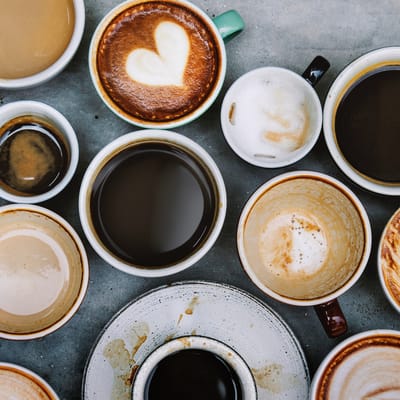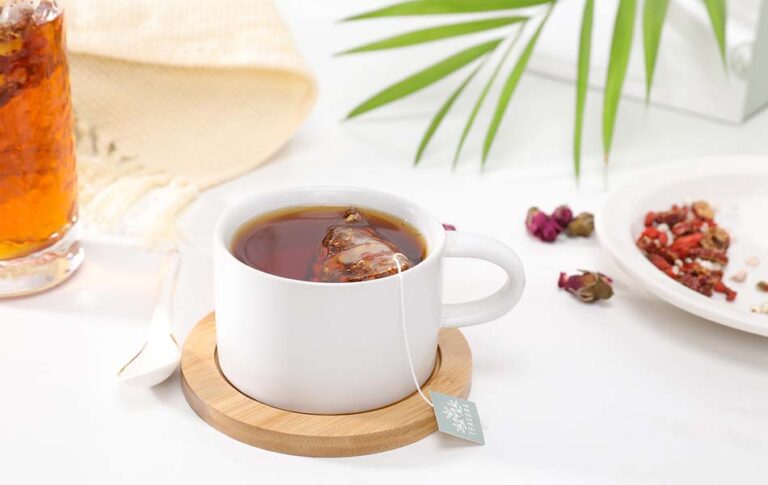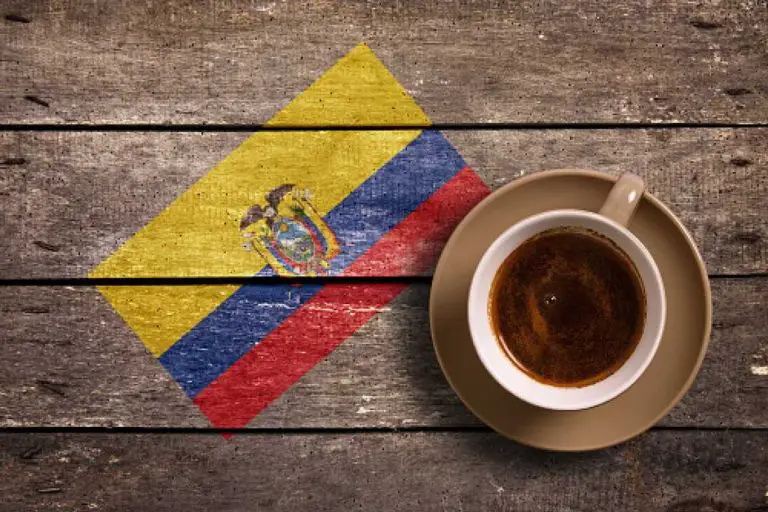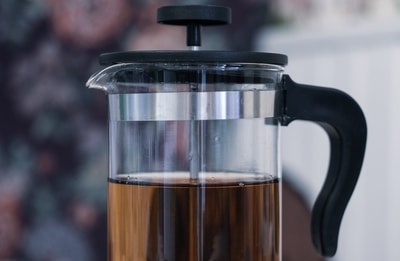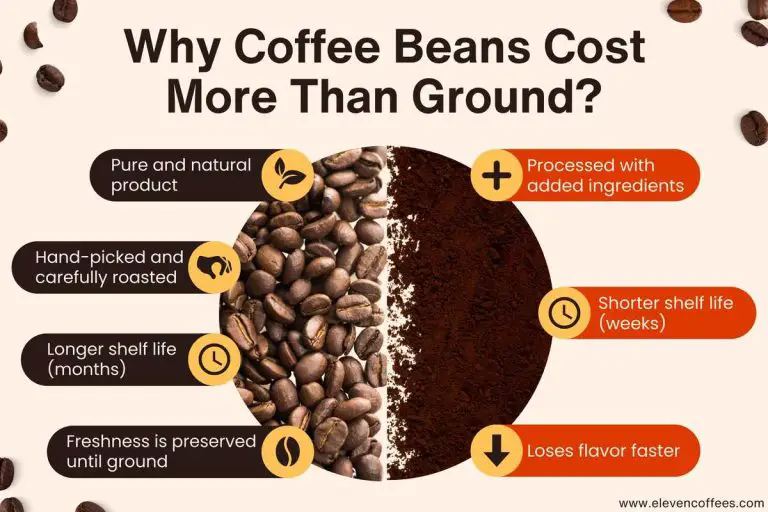38 Popular Types Of Coffee Drinks Explained
The seemingly endless list of coffee drinks found on café menus can be overwhelming. We’ve put together the most comprehensive list of all the different types of coffee-based drinks you’ll find online.
We explain in simple terms the differences between the best-loved coffee drinks from around the world, including stunning pictures so you can easily decide what to order on your next visit to your favourite café.
Most Popular Coffee Drinks
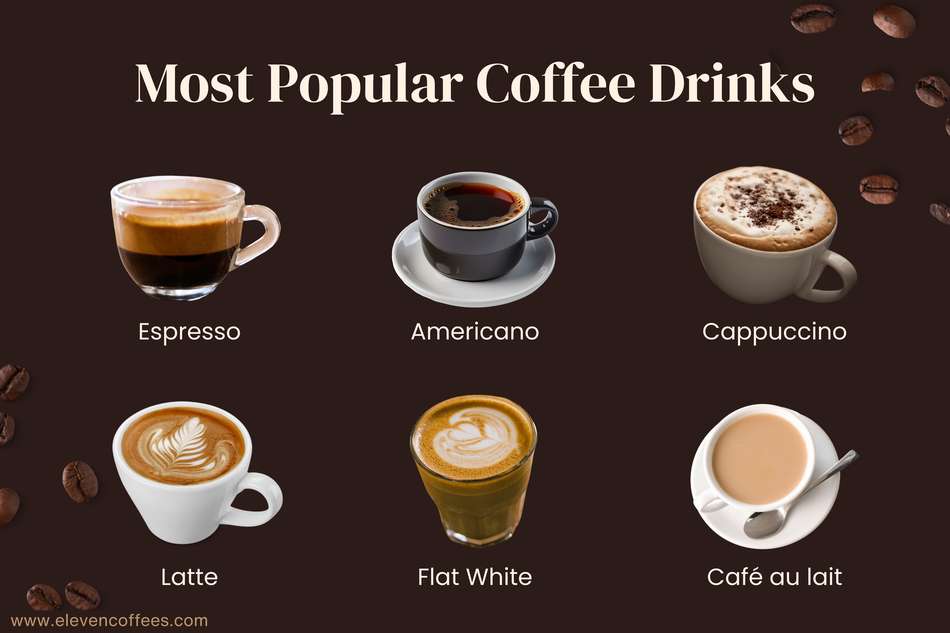
1. Espresso
Espresso (Italian, ‘pressed out’) is a small, concentrated coffee served in a demitasse. An espresso machine makes it by forcing water at a temperature of around 96°C (205°F) through a compact puck of coffee using approximately nine bars of pressure.
The coffee to water ratio is usually between 1:2 – 1:2.5. The result is an intensely strong coffee with a lot of body and mouthfeel.
Because of its intensity, baristas use espresso as a base for drinks with milk.
The beverage can be either a single or double shot.
- A single espresso shot typically contains between 7 – 9g of coffee, with the resulting drink containing 14 – 23g of liquid coffee.
- A double espresso shot typically contains between 14 – 18g of coffee, with the resulting drink containing 28 – 45g of liquid coffee.
2. Americano
A typical Americano (Spanish, ‘American’)[1] coffee starts its life as either a single or double shot of espresso. They dilute the espresso by combining it with freshly boiled water.
The amount of water added varies greatly depending on preference. Users might add anywhere from 30ml to 300ml (1 to 10 fl oz) of water.
The resulting drink is much like a filter coffee in body but has quite a different taste due to the preparation method of diluting.
3. French press
The French press, also known as a cafetière, is a type of infusion (or full-immersion) brewer. The French press, also known as a cafetière, serves as a type of infusion (or full-immersion) brewer. Users add medium to coarsely ground coffee to the brewer along with near-boiling water. They leave the coffee and water to steep for anywhere from 4 to 15 minutes.
They plunge a lid containing a mesh filter inside the brewer to filter the coffee. The result is a coffee with a lot of body due to the inherent coffee oils passing through the mesh filter. It also contains a heavy mouthfeel due to the tiny coffee ground sediment bypassing the filter.
A typical brew ratio is 1:13 (75g of coffee per litre of water).
4. Italian moka pot
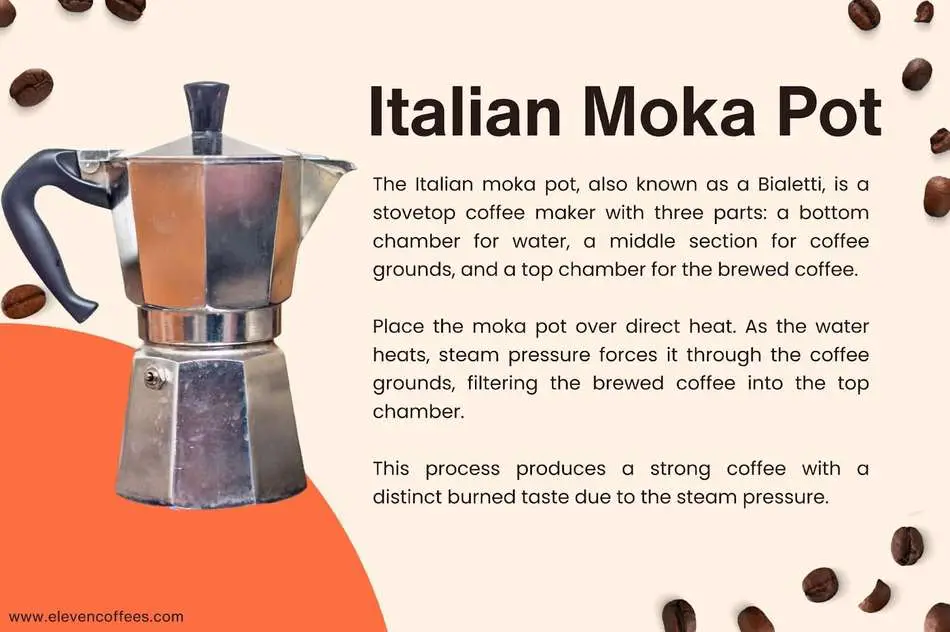
The Italian moka pot, also known as a Bialetti, is a stovetop coffee maker. The brewer splits into three parts: the bottom chamber for adding water, the middle section where a bed of finely ground coffee sits, and the top chamber.
The moka pot is placed over direct heat. As the water temperature increases inside the bottom chamber, the build-up in pressure forces the water through the bed of coffee and filters into the top chamber.
Due to the higher-than-atmospheric-pressure caused by the build-up of steam, the resulting brew is very strong with a burned taste.
The specialty coffee industry has attempted to improve the coffee produced in a moka pot; however, it remains unpopular due to superior alternatives.
A typical coffee to water ratio is 1:8 (125g of coffee per litre of water). Such a high coffee to water ratio only adds further to its harsh and bitter taste.
Bialetti invented the moka pot in Italy in the 1930s, which is why it has an alternative name.
5. Cappuccino
The cappuccino (Italian, ‘Capuchin’) is one of the most iconic drinks in the world. It typically consists of a single shot of espresso mixed with a layer of steamed milk and topped with a layer of foam. Baristas sometimes serve it with powdered chocolate sprinkled on top.
Cappuccino holds a special place in Italian culture. In Italy, people consume it only at breakfast until around 10 a.m.
The quality of cappuccinos varies significantly depending on the establishment or country. For instance, in France, they top it with Chantilly cream instead of steamed milk foam.
Interestingly, the word cappuccino did not get its name from the Italian word for ‘hood’ but from Capuchin, an Italian monk. They named the drink cappuccino because its color resembles the robes of the Capuchin monks.[2]
6. Latte
Latte (Italian, ‘milk’) is another popular coffee drink hailing from Italy. It typically consists of a single espresso shot mixed with steamed milk.
Again, the drink varies depending on the establishment. The main reason for the variation is the barista not knowing the difference between the milk-based drinks. Many, if not the majority of establishments, serve the same beverage for cappuccino, latte, and flat white.
Specialty cafés serve their lattes with latte art. The barista adds a range of designs, such as a rosetta or heart, using the steamed milk with the espresso crema.
7. Flat white
The flat white is the new kid on the block as far as milk-based coffee drinks go, and both Australia and New Zealand claim to have invented it. The flat white typically contains a double espresso mixed with steamed milk.
This coffee drink is similar to a latte but usually demands a slightly higher price due to the increased amount of coffee.
Specialty cafés also top the flat white with latte art designs.
8. Café au lait
A café au lait typically consists of filter-style coffee to which they add hot milk. This is usually a favourite at home as most people do not own an espresso machine and so are unable to produce espresso coffee.
The result is a much less intense coffee-with-milk drink due to the base being a filter coffee instead of espresso.
Espresso Machine Coffee Drinks
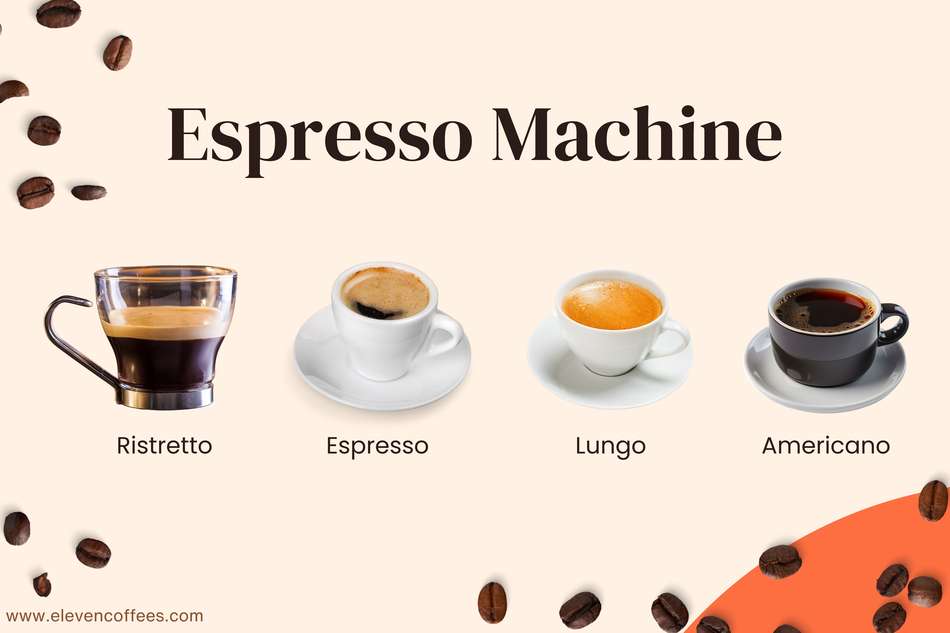
9. Ristretto
Ristretto (Italian, ‘restricted’) is similar to espresso but is even more concentrated.
Typical coffee to water brewing ratios are between 1:05 – 1:1.5. The result is an extremely viscous cup of coffee with an incredibly intense taste.
The drink was popularised in the specialty industry by David Schomer of Vivace in Seattle, USA.
Espresso Coffee Drinks
See espresso in Most Popular.
10. Lungo
The lungo (Italian, ‘long’) is a weaker version of an espresso. A typical coffee to water ratio of a lungo is between 1:3 – 1:4.
They do not dilute lungos by adding extra water as they do with Americanos. Instead, they prepare lungos in the same way as espresso but with a longer extraction time. As a result, lungos tend to be less intense with a sweeter and more muted acidity.
Americano
See Americano in Most Popular.
Espresso with Milk Coffee Drinks
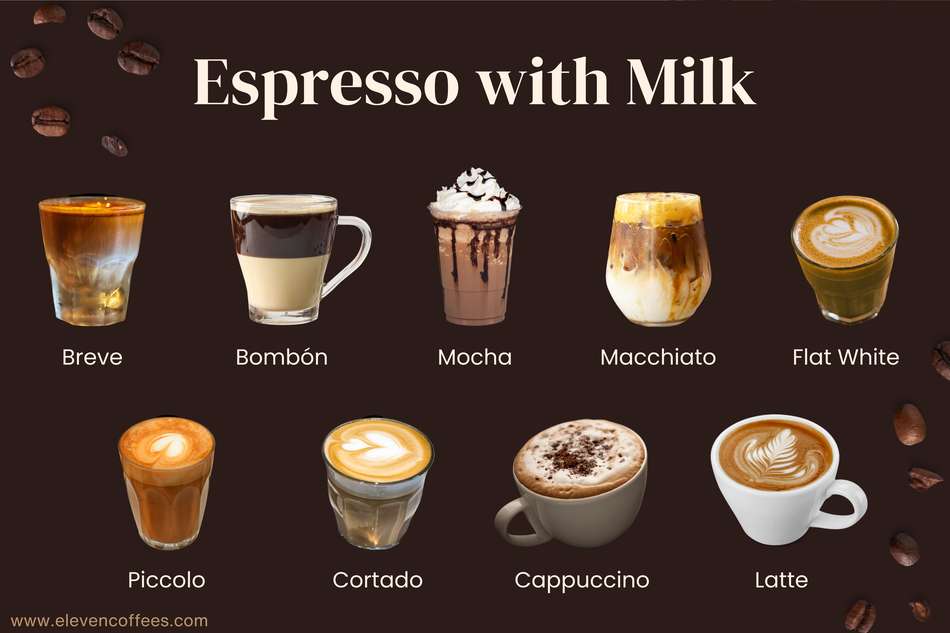
11. Breve
The breve (Italian for ‘short’) is an American version of a latte. It typically consists of a single shot of espresso combined with a half-and-half mixture of milk and cream, which they steam and partly froth.
They add the steamed milk-cream in a 1:1.5 ratio of espresso to milk-cream and top it with a dollop of the frothy milk-cream.
12. Bombón
First popularized in Valencia, Spain, the café bombón (Spanish for ‘bonbon’) combines espresso with sweetened condensed milk at a 1:1 ratio.
This is an identical copy of an Asian drink popular in Malaysia, Thailand, and Singapore.
Baristas often serve the drink in a glass to showcase the separate layers of coffee and condensed milk.
13. Mocha (mochaccino)
The mocha (or mochaccino) is an espresso-based drink mixed with milk and chocolate. A typical recipe uses equal parts espresso, milk, and chocolate powder, and they sometimes top it with Chantilly cream.
Depending on the establishment, they may substitute the chocolate powder with chocolate syrup or even milk or dark chocolate.
14. Macchiato
The macchiato (Italian, ‘stained’) is an espresso-based coffee that contains a dollop of foamed milk. A typical macchiato will consist of a single or double espresso with equal parts milk.
15. Piccolo
The piccolo (Italian for ‘tiny’) became popular in the Sydney coffee-drinking scene. Baristas typically make it from either a ristretto or espresso and combine it with steamed milk to produce a drink of around 100ml. Essentially, it serves as a baby latte.
16. Cortado
The cortado (Spanish, ‘cut’) is very similar to the macchiato. However, a typical cortado uses steamed milk instead of foamed, and it has a coffee to milk ratio of 1:1 – 1:2.
People know the drink by several names, such as ‘tallat’ in Catalan, ‘pingo’ or ‘garoto’ in Portuguese, and ‘noisette’ in French. It remains popular in Spain, Portugal, and Latin America.
Cappuccino Coffee Drinks
See cappuccino in Most Popular.
Latte Coffee Drinks
See latte in Most Popular.
Flat White Coffee Drinks
See flat white in Most Popular.
Filter Coffee Drinks
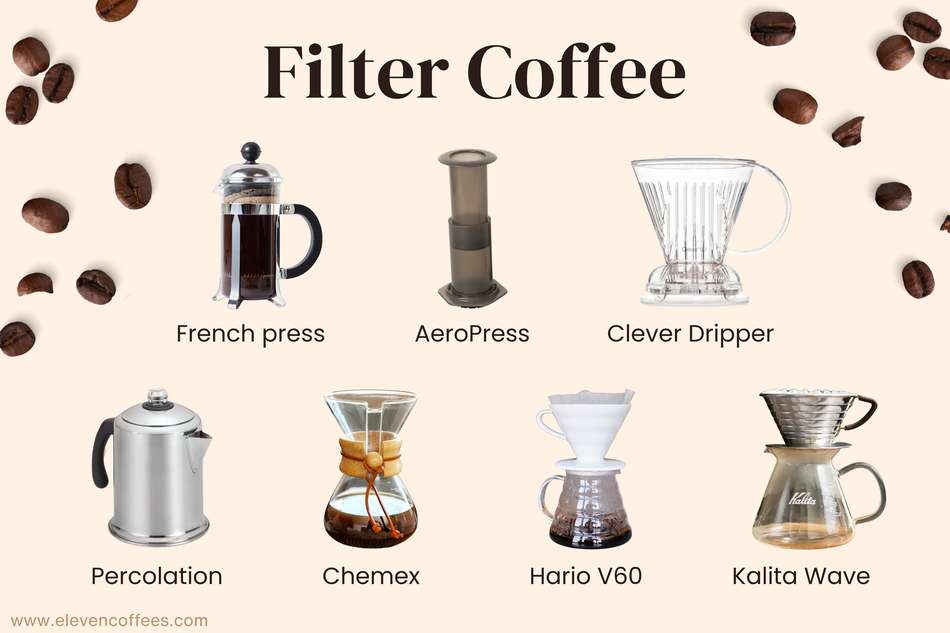
Infusion Coffee Drinks
Infusion brewers involve adding all of the coffee and water to the brewer, allowing them to steep together to create an infusion. They also refer to these brewers as full-immersion brewers.
Full-immersion brewers include the French press, AeroPress and Clever Dripper. Full-immersion differs from pour-over because users add all of the water to all of the coffee at once. Depending on the grind size, they leave the coffee to infuse (extract) for anywhere from one to 30 minutes.
Depending on the type of brewer, brewers filter the coffee using either a disposable paper filter or a reusable metal filter.
The recommended dose for infusion brewers is a coffee to water ratio of 1:13 (75g of coffee per litre of water).
French Press Coffee Drinks
See French press in Most Popular.
17. AeroPress
The AeroPress is the new kid on the block in the world of infusion brewers; however, it has also become one of the most widely known and popular brewers globally.
Pretty much any coffee will work well in the AeroPress which is why this is such a popular brewer. Through different brewing parameters, you can increase or decrease the body, acidity and sweetness with ease.
Unlike other infusion brewers, the AeroPress filters coffee through its dedicated paper filters, which results in a clean cup that highlights the coffee’s characteristics.
18. Clever Dripper
The Clever Dripper is, in my opinion, the best entry-level infusion brewer on the market. It works much like a French press but with the bonus of a paper filter.
Its plastic construction means it’s pretty much unbreakable, and it’s very simple to clean.
The Clever Dripper produces a robust cup of coffee that you would expect from an infusion brewer but, because of the paper filter, the resulting cup is cleaner with more clarity of flavour.
Percolation Coffee Drinks
Baristas prepare filter coffee by slowly adding near-boiling water to a bed of coffee, a method known as percolation or pour-over.
The water passes through the bed of coffee and into the brewing vessel. They filter the coffee using paper, cloth, or a reusable plastic or metal filter. Filtration by paper filter results in a very clean, acidic coffee with a complex range of flavours that have excellent clarity.
The specialty coffee industry highly favors this brewing method for its clarity of flavor. A typical coffee to water ratio is 1:16 (60g of coffee per litre of water).
Cloth is an excellent way to filter the ground coffee whilst retaining the inherent coffee oils to produce a coffee with more mouthfeel. However, because cleaning cloth filters is difficult, people do not commonly use them, and they are almost never seen in coffee shops. It’s my preferred choice for filtering cold brew.
Popular percolation brewers include the Chemex, Hario V60, and Kalita Wave.
19. Chemex
The Chemex Coffeemaker was invented in 1941 by Peter Schlumbohm. The brewer has been popular across the States for many decades and even features in the series Friends.
Its shape owes itself to its designer and is of one solid construction. The papers are some of the largest you will find and are much thicker than that of other brewers.
A lot of discussion has arisen over the years with claims that the Chemex is unable to produce uniformity when brewing and is therefore inferior to other brewers such as the Hario V60.
20. Hario V60
The V60 is a much-loved brewer by Japanese coffee manufacturer, Hario.
The brewer comes in several materials such as glass, ceramic, stainless steel, copper and plastic. It comes in two sizes, the 01 and the slightly larger 02. The V60 has its own dedicated paper filters that come in bleached and unbleached versions.
The V60 brewer is definitely one for the advanced user as it can be tricky to master due to its shape. The 60 in the name is reference to the 60º angle of its cone.
When brewed properly, the V60 produces an incredibly clean cup that highlights the coffee’s flavour and acidity.
21. Kalita Wave
Another extremely popular brewer is the Wave made by the family-owned Japanese company, Kalita.
The brewer also comes in several materials such as glass, ceramic and stainless steel. The brewer comes in two sizes: the smaller 155 version and the larger 185 version. It also has its own dedicated paper filters.
Due to its flat-bottomed base, many prefer the Kalita Wave due to its ease in repeatability.
The Wave is definitely a rival to the V60 as it also produces stunningly beautiful-tasting coffee.
Cold Coffee Drinks
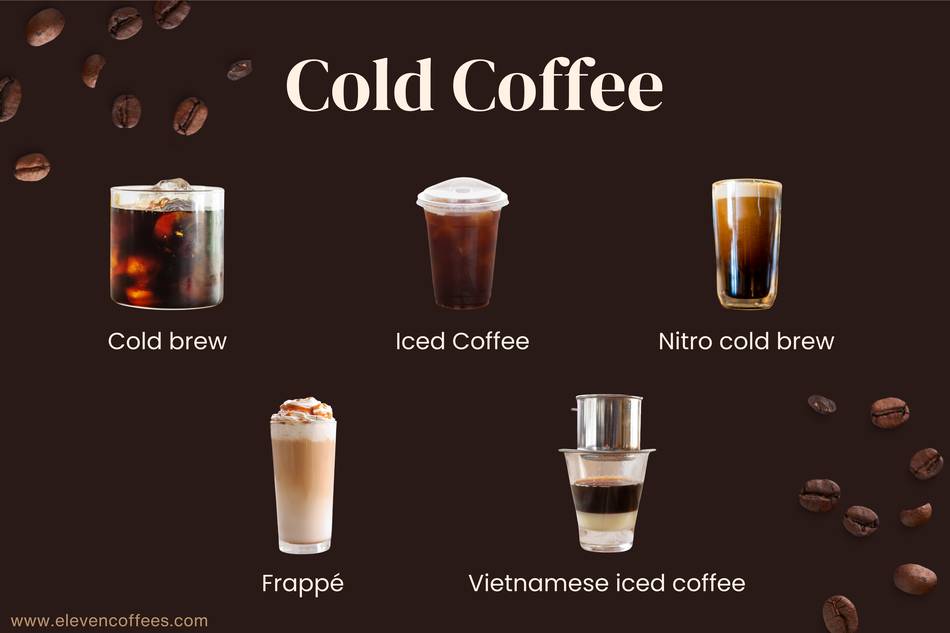
22. Cold brew
Cold brew coffee is a method of preparation that involves combining medium to coarsely ground coffee with cold or room-temperature water and leaving to steep from anywhere between 12 – 24 hours.
The result is a coffee with flat and muted flavours but with little bitterness. It is often combined with ice cubes and milk for a refreshing summer’s drink.
The low level of bitterness is due to how coffee reacts with water. You can read about bitter-free coffee in my article.
Cold brew is very simple to make and will have you drinking coffee quicker than you can make instant. Check out my cold brew guide for recipes and tips.
23. Iced coffee
Iced coffee is freshly brewed, hot coffee that is cooled instantly by brewing over ice. Usually, it’s the preferred choice of cold coffee by specialty baristas due to its more interesting and complex flavour profile when compared to cold brew.
It is usually prepared using a pour-over brewer such as a V60, Chemex or Kalita, using a higher-than-normal coffee to water ratio to account for its dilution in ice.
24. Nitro cold brew
Nitro cold brew coffee is cold brew coffee that has been infused with nitrogen. The result is a drink that is smoother and richer with a creamy head. The tiny nitrogen bubbles also contribute to a fuller mouthfeel.
It’s much like nitrogen-infused stouts such as Guinness. In fact, when the drink is being poured, you could easily mistake it for a glass of Guinness.
25. Vietnamese iced coffee
Cà phê đá (Vietnamese, ‘iced coffee’) is made with medium to coarsely ground coffee using a small, metal, Vietnamese brewer known as a phin cà phê.
Coffee is added to the base of the phin and covered with a dispersion screen that contains small holes. Water is poured into the brewer and extraction is allowed to occur over the course of around 10 minutes.
The coffee is then mixed with condensed milk in varying quantities depending on the establishment and then poured over ice.
26. Frappé
Frappé (French, ‘chilled,’ ‘iced’) is an iced coffee originating in Greece. It typically consists of instant coffee combined with water, sugar and ice. It is also sometimes combined with milk. Frappé is a typical beverage found on menus throughout Greece.
The drink has been popularised in recent years by companies such as Starbucks with versions such as the Frappuccino. Nowadays, it’s more akin to a milkshake. Espresso-based coffee is combined with cold milk, crushed ice, a flavoured syrup, and topped with Chantilly cream.
Decoction Coffee Drinks
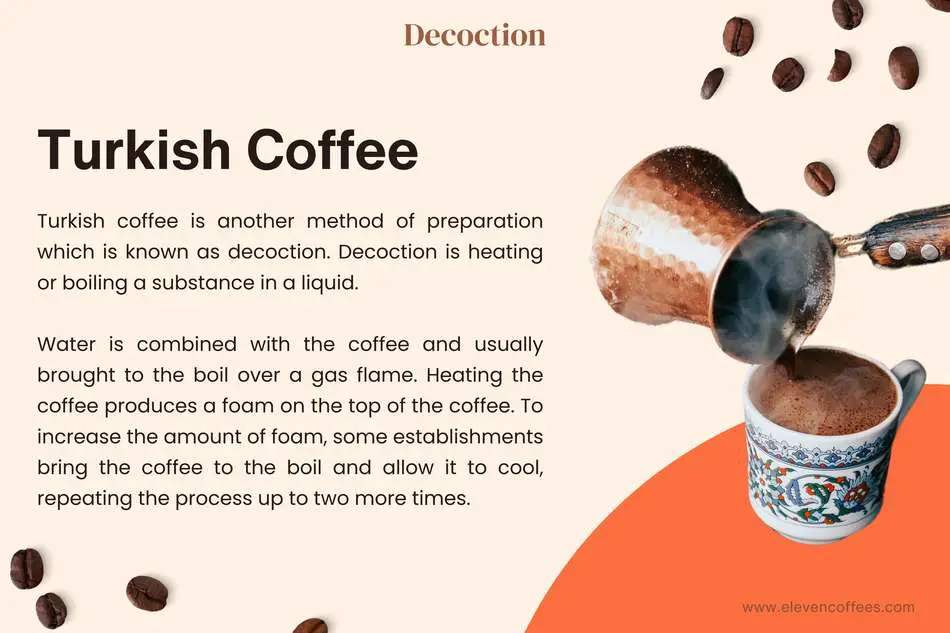
27. Turkish coffee
Turkish coffee is another method of preparation which is known as decoction. Decoction is heating or boiling a substance in a liquid.
Turkish-style coffee is enjoyed throughout Turkey and other neighbouring countries. The coffee is ground finer than that used for espresso and added to a cezve (also known as an ibrik), a small pot with a long handle.
Water is combined with the coffee and usually brought to the boil over a gas flame. Heating the coffee produces a foam on the top of the coffee. To increase the amount of foam, some establishments bring the coffee to the boil and allow it to cool, repeating the process up to two more times.
The result is an intensely strong coffee which is overwhelmingly bitter. Find out more about Turkish coffee and its mark on coffee’s history by reading my article.
Vacuum Coffee Drinks

28. Siphon
Siphon is a brew method all of its own along with filter, espresso, Turkish, and cold coffee. It is also known as vac pot (vacuum pot).
This brewing method consist of two chambers, one on top of the other, with a paper, cloth or metal filter sitting in the middle. Water is added to the bottom chamber and the coffee sits in the top chamber.
Heat is applied to the bottom chamber and, as the temperature increases, the vapour pressure of the water increases, pushing the water upwards into the top chamber to infuse with the coffee.
Once the coffee has infused sufficiently, the heat source is taken away, and the coffee draws down through the filter and into the bottom chamber ready to serve and drink.
When made correctly, the resulting cup exhibits good body with a crisp and clean finish.
However, this method is not commonly found due to how difficult is it to maintain consistency. A halogen heater is often used by quality, specialty establishments due to its more reliable and consistent temperature.
Freeze-dried and Spray-dried Coffee Drinks
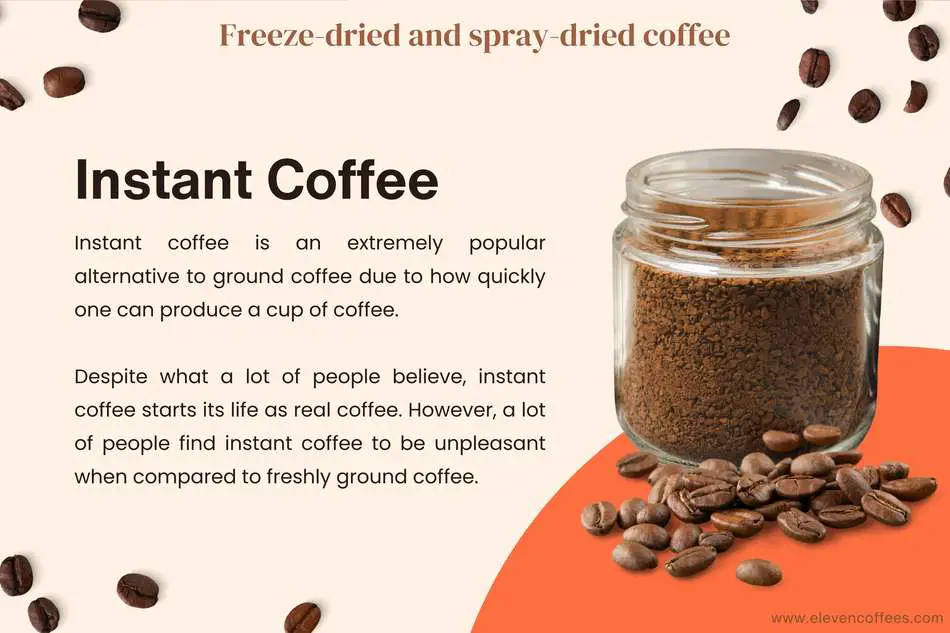
29. Instant coffee
Instant coffee is an extremely popular alternative to ground coffee due to how quickly one can produce a cup of coffee.
Almost 50 percent of the world’s coffee is made into instant coffee. Around 70 percent of UK homes use instant coffee whilst only seven percent do so in America and one percent in France.
Despite what a lot of people believe, instant coffee starts its life as real coffee. However, a lot of people find instant coffee to be unpleasant when compared to freshly ground coffee.
Find out how Nestlé makes its world-famous Gold Blend by reading my article.
Coffee Drinks with Alcohol
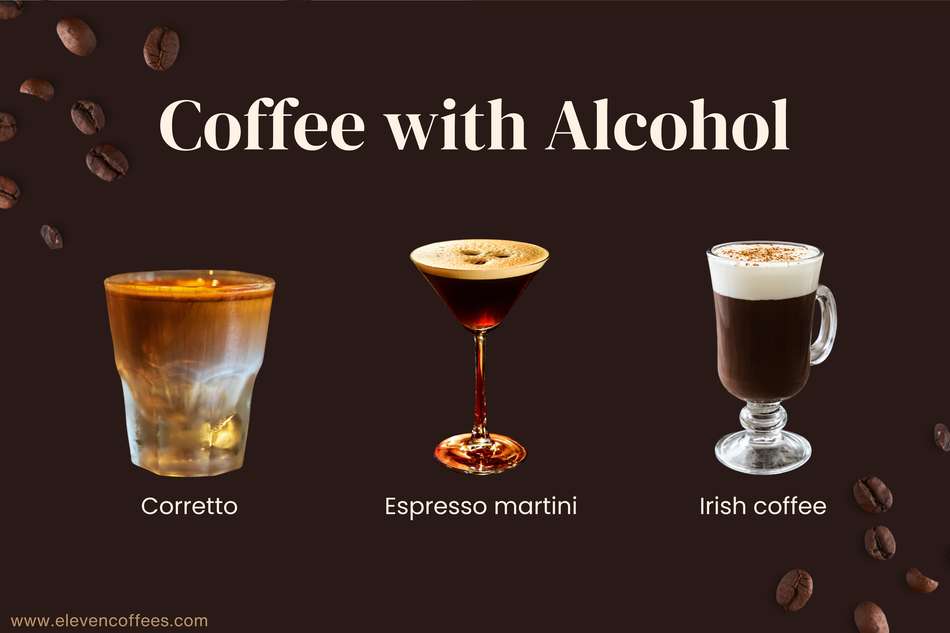
30. Corretto
The caffè corretto (Italian, ‘corrected’) is an Italian drink that combines a shot of espresso with either grappa, sambuca, or brandy.
Most cafés serve the drink with the alcohol already combined; however, at some establishments, the alcohol is served in a shot glass alongside the cup of espresso.
Occasionally, some cafés serve regular customers the espresso alongside a bottle of the alcohol so that the customer can prepare it to his or her liking.
In Italy, the drink would be ordered as followed:
- un caffè corretto alla grappa
- un caffè corretto alla sambuca
- un caffè corretto al cognac
31. Espresso martini
An espresso martini is a cold cocktail that contains a shot of espresso (or ristretto), vodka, coffee liqueur, and sugar syrup.
The coffee liqueur is usually Kahlua, Tia Maria, or a homemade coffee liqueur.
The ingredients are combined in a cocktail shaker that is filled with ice. The mixture is shaken, strained, and poured into a chilled martini glass.
The drink is traditionally garnished with coffee beans and, occasionally, a twist of lemon zest.
32. Irish coffee
The Irish coffee (Irish: caife Gaelach) is a hot cocktail that traditionally consists of hot coffee, Irish whisky, sugar, and thick cream. The drink is served in a clear glass.
The coffee may be a shot of espresso or some sort of filter-style coffee. The drink is prepared by dissolving sugar into the hot coffee and then combining with Irish whisky.
The cream is then added by pouring it over the back of a spoon just above the surface of the coffee to ensure that the cream floats. The coffee is drunk through the cream, which is sometimes dusted with cocoa powder.
Other Coffee Drinks
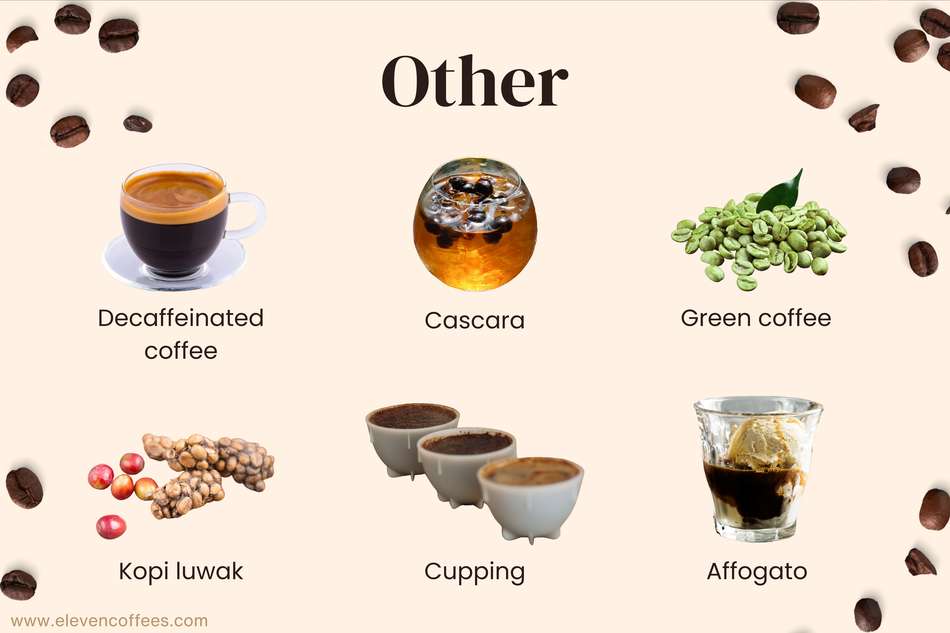
33. Decaffeinated coffee
Decaffeinated coffee is coffee that has had almost all of its caffeine removed. Decaffeination is carried out before the green coffee beans have been roasted.
For a coffee to be considered and sold as decaffeinated in the United States, at least 97% of the caffeine must be removed.[3]
Under European law, ground or whole bean decaffeinated coffee must be 99.9% caffeine-free, and instant coffee must be 99.7% caffeine-free.[4]
In Canada, ground or whole bean decaffeinated coffee must be 99.9% caffeine-free, and instant coffee must be 99.7% caffeine-free.[5]
Under Australian and New Zealand law, decaffeinated coffee needs to be 99.9% caffeine-free.[6]
34. Cascara
Cascara is made from the outer skin of the coffee cherry, which is the fruit that houses coffee beans.
Workers pick the coffee cherry fruit from the coffee plant and then pulp it to remove the cherry and extract the seed. The seeds are what we refer to as coffee beans.
When the outer skin is dried in the sun, it’s referred to as cascara and can be made into a tea-like infusion. Cascara is from the Spanish word cáscara meaning skin or peel.
Depending on the processing method used, cascara tea can have flavours ranging from dried fruits and berries to floral and even earthy, tobacco notes.
If you would like to know more about cascara or you would like to make yourself a cup, have a read of my article all about cascara.
35. Green coffee
Consuming unroasted, green coffee is becoming somewhat of a trend in recent years in part due to it being a supposed weight-loss aid as well as having other health benefits.
To prepare green coffee, boil fresh, whole beans in water and, once infused, strain to remove the beans.
Some countries sell ready-prepared green coffee drinks in bottles or cans.
36. Kopi luwak
Kopi luwak (koh-pee loo-wah) is a type of coffee bean and one of the most expensive and controversial on the planet. It is produced from the beans inside the coffee cherries eaten by the Asian palm civet that pass through undigested into the civet’s faeces.
The civet is very selective when it comes to the coffee cherries, selecting only the ripest. The civet’s stomach enzymes reduces the coffee bean’s bitterness, which is one reason coffee lovers love kopi luwak.
The controversy surrounding the production of kopi luwak coffee is due to animal welfare. Originally, people collected coffee beans from the droppings of wild civets. However, given its popularity and value today, people have taken to caging civets much like battery-farmed chickens, force-feeding them coffee cherries to produce higher yields.
Due to the living conditions, the mortality rates are very high which is producing a risk to conservation. Researchers have also found evidence that the SARS virus originated from civets.[7]
Read more about kopi luwak and the controversy surrounding it here on ElevenCoffees.com.
37. Cupping
Cupping coffee is not a drink that you can order in a café but a way of comparing and contrasting two or more coffees.
In the industry, professionals conduct cupping to evaluate a coffee’s quality. Coffee roasters use it to test roast quality, cafés sample new coffees for their menus, and home enthusiasts engage in cupping to enhance their knowledge of coffee.
Cupping coffee is a lot of fun and really shows off the diversity of coffees from around the world. Read my article on how to easily cup coffee at home.
38. Affogato
Affogato (Italian, ‘drowned’) is a coffee-based dessert. It typically consists of a scoop of vanilla ice cream doused with a shot of fresh espresso.
The English name ‘espresso affogato’ causes confusion as it’s not the espresso that is drowning but the ice cream. In Italy, they call it ‘affogato al caffè’ (loosely: ‘drowned in coffee’), which correctly implies that the ice cream is drowning, not the coffee.

